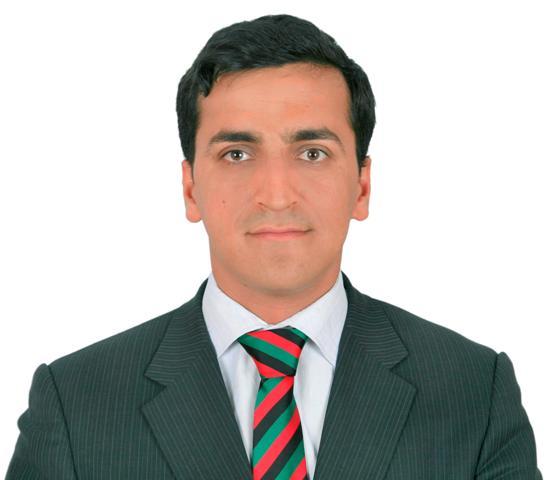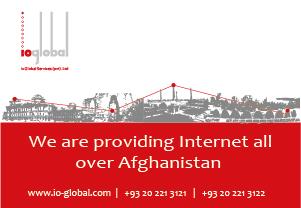The Afghanistan of 2001 is not comparable to the Afghanistan of 2013. As a citizen of the country, I have lived my entire life in Afghanistan; I can easily see the rapid development and progress. Many non-Afghans don’t see this progress, dwelling instead on those parts of the country that have yet to measure up to outsiders’ standards.
People such as myself who have seen a devastated Afghanistan appreciate the improvements visible all around. It is an old country, but with a new youthful generation eager to begin making contributions. It is a country that experienced two decades of war, followed by 12 years of international efforts to stem the spread of terrorism and militancy. Some threats still remain, but the 352,000-strong Afghan National Security Forces (ANSF forces, offer assurances that Afghanistan will never go back to the dark ages.
In the past 12 years, together with its international partners and coalition forces, Afghanistan has created sufficient political, economic and social forces that will safeguard the country against the return of the miseries of the past. Afghans have taken courageous steps in reasserting their freedom, sovereignty and international status. Established institutions, laws and strategies for the present and future have enabled Afghans to take charge of their own destiny. Examples include the country’s decision to assume responsibility for its security and to hold two presidential and parliamentary elections.
While safeguarding these achievements, Afghans will continue to broaden those accomplishments through the decade of transformation, from 2014 to 2025. This was agreed to at the International Afghanistan Conference in Bonn in December 2011 and supported by the NATO Chicago Summit in May 2012 and Tokyo Conference on Afghanistan in July 2012. Of course, Afghanistan is not a perfect country and will still require the assistance and support of the United States and the international community. But long-term commitments by the U.S., NATO and other countries assure the future stability of this country.
The transfer of security to the ANSF and the end of the International Security Assistance Force mission — an outcome desired by the Afghan government — has created uncertainty among the Afghan people. But reassurance comes in the form of NATO’s announcement of a post-2014 mission to train, advise and assist the Afghan National Security Force, a mission called Resolute Support. The majority of Afghans — and those trying to destabilize the country — have learned that the country will not be abandoned by the U.S. and the international community. Progress and development will continue.
Triumphs of youth:
Afghans have many reasons to be optimistic and hopeful. Sixty-five percent of the population is under the age of 25, making youth a major force in society, both regionally and internationally.
Twenty-one-year-old Ruhullah Nekpa became a national hero after winning Afghanistan’s first ever Olympic medal at the 2008 Beijing Olympics, and he managed to bring home a second medal in taekwondo from the 2012 London Olympics. Starting from scratch, Afghanistan’s national cricket team defeated Kenya to finish second in the International Cricket Council (ICC) World Cricket League Championship in October 2013. The team qualified to play in the ICC Cricket World Cup 2015 in Australia and New Zealand.
The country’s first national football association, the Afghan Premier League, was founded in 2012. Just a year later, it beat India to win the South Asian Football Federation Championship. This was not just a sport’s cup: For many Afghans, it was a sign of Afghan unity. For the first time in my life, I witnessed 24-hour, nonstop parties around Afghanistan in which millions of people came together and celebrated the historic football victory. That turned out to be a day of hope, solidarity and peace in Afghanistan.
Coincidentally, that victory occurred on September 11, 2013, exactly 12 years after the al-Qaida attack on the U.S.
That attack was planned by the terrorist group from bases inside Afghanistan. I still remember the day. There was only one radio station, and it was run by the Taliban. Few Afghans were able to listen secretly to other radio stations out of fear of the Taliban. I happened to be listening to the BBC and learned about the 9/11 attack. The Afghan people were shocked by the news. Some Afghans were living in fear, but many in sorrow. I could never imagine that only 12 years later that Afghanistan would no longer be a safe haven for al-Qaida and terrorists, but instead would be celebrating a peaceful sports triumph.
From that single radio station, Afghanistan now possesses 75 TV stations and 180 radio stations. Millions of Afghans watched and listened to these media outlets, without any fear, for the good news of the football victory. Most of the 18 million Afghan mobile phone subscribers and nearly 1 million Internet users were busy that day. It was a day that ethnicity, language, faith and culture were not important, and people of all genders and ages were celebrating.
All of this was a tribute to the influence of Afghan youth and the joint sacrifices made by Afghans and their international partners. Just 12 years earlier, the Taliban had banned many Olympic sports and were using the national football stadium to execute men and women.
Considering that such a large percentage of the population consists of children and teenagers, a huge portion of the country has little or no memory of the Taliban regime. This fact has both positive and negative aspects. While many of this generation would view the Taliban as alien, others might be influenced by a violent movement they never experienced firsthand in the old days. The kids who were in their first years of school during the Taliban era have already graduated from high school, and some are enrolled in the universities.
Afghanistan has more than 10.5 million students engaged in all levels of education. This is one-third of the entire population, and 37 percent of those students are girls. More than 4,500 school buildings were constructed since 2003. Just a decade ago, there were fewer than 1 million students, with almost no female participation. All of this amounts to fundamental change and investment.
I would like to briefly mention three things I believe can contribute to better security, good governance and economy stability for Afghans, young and old alike. To further strengthen and widen these gains, we should focus on the following key issues:
Good Governance and Fighting Corruption:
Democracy is a new phenomenon in Afghanistan, where it’s been practiced for only a decade. Governments and institutions work differently in democratic societies. So it’s not only fighting terrorism and extremists, but good governance that is a key priority for Afghanistan. Weak rule of law and the existence of “impunity circles” and safe havens for corrupt individuals and officials in Afghanistan and abroad have contributed to violations of human rights and injustice.
Nearly all of Afghanistan’s problems — instability, poppy cultivation, drug trafficking and disillusionment with government — are traceable to corruption.
The Afghan government and its international partners should not ignore the issue of corruption. The fight against it should be a priority. The Tokyo Mutual Accountability Framework, agreed to in 2012 by the Afghan government and its international partners, should be fully implemented. Civil society and the independent media should play a role in monitoring corruption with the support of the Afghan government and international community.
Security Sector Reform:
The Afghan security sector has come a long way in terms of quantity. It’s time to focus on quality and in-depth security sector reform. The focus should be on nurturing educated, professional and well-trained officers and generals. The Afghan constitution has empowered citizens, and they will no longer tolerate unscrupulous and unskilled commanders.
Leadership development, gender mainstreaming and accountability mechanisms in the security ministries should be prioritized. Aside from senior experienced officers and noncommissioned officers, Afghanistan needs to develop the capacity of young soldiers who will replace the older generation in the ANSF.
It is also time to professionalize the police and draw greater distinctions between the duties of law enforcement and the military.
Regional Cooperation And Economic Development:
Afghanistan has gained a nickname — the Heart of Asia — so regional cooperation and dialogue are very important. In the long term, Afghanistan can’t rely on the donations and support of the international community. To address these issues, short- and long-term strategies have to be set.
Employment and economic opportunities are some of the best solutions to counter terrorism, and they also aid the state-building process. Revival of the Silk Road as a form of Eurasian inland economic architecture is an important element. Afghanistan is landlocked but is well-positioned to promote trade and transport links between Asia and Europe. Through its natural geographical location at the crossroads of Eurasia, Afghanistan can be used to boost commerce between East and West.
The country is one of the facilitating locations for the transfer of energy, communications, transportation and trade development in the region. The renewal and promotion of the Silk Road will connect countries of the region with the rest of the globe.
The result will be increased regional and global security. Besides the trade passageways, Afghanistan offers unique opportunities for investment and business development. It has enormous explored and unexploited natural resources, including minerals, gas, oil, hydrocarbons and other materials that are worth trillions of dollars and are crucially needed within the region and across the world.
Conclusion:
A sign of progress is the Alliance in Support of the Afghan People, a bipartisan coalition of U.S. and the Afghan civil society leaders, senior former officials and diplomats. The alliance is dedicated to preserving and protecting the progress made by the Afghan people during the past 12 years. This is yet another clear example of strong Afghan-U.S. relations. Surveys show that millions of Afghan citizens appreciate the contributions of the American people and their government. Such support has resulted in a remarkable change to every aspect of Afghan life and has enabled us to rejoin the world community.
Afghanistan is not perfect, and state building is a long-term process. A deeper focus on good governance, security sector reform and economic development would help ensure that Afghanistan’s youthful population will not only thrive in the years ahead but will contribute to regional and international peace and security.
Afghan Security with a Young Face:
Abdul Sami Qais is 24 years old and the sole breadwinner for his family. He lives with his parents and seven younger siblings in the relatively peaceful city of Mazar-e Sharif in Afghanistan. Since 2011, he has been working as an interpreter with NATO’s International Security Assistance Force in northern Afghanistan.
His family is lucky to have someone with a job at all. Unemployment among young Afghans hovers above 35 percent and is set to rise further as Afghans take the lead in providing security for their country.
NATO has provided direct employment to thousands of Afghans working as translators, surveyors, cooks and cleaners. Many more are employed as laborers and drivers by NATO’s construction and logistical contractors.
One company alone — Mission Essential — employs about 7,200 Afghans as linguists and translators. In 2011, Afghans working for international companies and nongovernmental organizations paid 22 percent of the $120 million income tax paid that year, according to the Afghan Ministry of Finance.
As Afghanistan takes full control of its security, fewer of these jobs will be available for young Afghans such as Qais. However, the young interpreter, who is also an engineering student, remains upbeat and is planning for the future.
“I would like to join the Army right after the completion of my studies. Just as the country needs Army and police alongside the civil sector, the Army also needs educated youth like me who can work in the administration section of the Army,” he said.
Qais used to be skeptical of the Army and could not understand why his peers chose to enlist instead of getting an office job and sleeping comfortably at home every night. However, since participating in joint operations with the Afghan National Army (ANA) and NATO forces, he has changed his mind.
“I was wrong. If youth like them don’t risk their lives in maintaining the security of fellow citizens, no one will be able to sleep well,” he said.
He is not alone in his appreciation of the military’s efforts to take over the responsibility for the country’s security from the international forces. A 2013 survey by The Asia Foundation suggests Afghans maintain high levels of confidence in the ANA and Afghan National Police (ANP). According to the survey, 91 percent of respondents reported that ANA is improving security, while 86 percent said the ANP also is improving security.
Today, Afghan security forces serve on the front line of every operation, be it sweeping operations against terrorists, defending the country’s borders or ensuring the security of citizens by detecting and defusing terrorist plots. This has contributed to an increase in the number of young Afghans seeking employment with the national forces.
“There are enormous numbers of youth volunteers who are willing to join the Afghan National Army. We do not need any promotional advertisement to encourage the youth,” said Gen. Mohammad Zahir Azimi, spokesman for the Afghan Ministry of Defense.
The numbers prove this: Since March 2011, the Afghan National Security Forces have grown from 284,952 members to 344,108, including 194,466 Soldiers and 149,642 police, according to a report published in 2013.
The military has been less successful in encouraging young women to join. In Afghanistan, some expect women to stay at home with children or work civilian jobs, if they work at all. The Afghan Ministry of Defense produced promotional videos to encourage women to enlist, but the results have been marginal. As of January 2014, women represented only 1,000 Soldiers in an Army of 195,000.
“To increase the number of women in the National Army, we need to build the culture for it, which requires a longer time for people to accept allowing their daughters and wives to join the National Army,” Azimi said.
Cpl. Sughra Ebrahimi, a 29-year-old mother of three, is one of the few women working with the Afghan Border Police. For the past three years, she had been accompanying her brothers-in-arms in field operations. She believes the police force needs women in the same way that society needs women doctors, teachers and nurses.
“During important national events like the election days, it is the women police who play crucial role in searching the women at the polling stations and ensuring the security of voters. … When we come across any suspicious woman, or when any male insurgents take shelter under a burqa, it is women police who enter among other women and catch that insurgent,” she said.
Women are also encouraged to find employment in other professions traditionally regarded as male. Out of 30,000 Afghan youth engaged in vocational training established by the Afghan Ministry of Labor, Social Affairs, Martyrs and Disabled, 40 percent were women and young girls. They are receiving training in electrical equipment repair, auto mechanics, carpentry and tailoring.
Politics is also opening up to women, with 20 percent of the seats in the Afghan National Assembly allocated to them, according to The Asia Foundation. In January 2014, there were a total of 117 women among the 34 provincial councils, three female ministers and one female governor.
Despite these advances, the political and security situation in Afghanistan remains tense. Afghan civilian casualties have increased as terrorist groups have stepped up attacks. As long as peace talks fail to produce significant results, insecurity will continue as the country’s biggest concern. Other challenges include unemployment, corruption, inefficient government and administration, and the slow pace of economic recovery and reconstruction. Corruption, in particular, is significant. In Transparency International’s 2013 comparative analysis of citizen perceptions of corruption, Afghanistan was tied with North Korea and Somalia for last place out of 177 countries. The annual cost of corruption is estimated at $3.9 billion, according to The Asia Foundation.
This is the reality young Afghans need to address. To do just that, a hopeful group of young politicians, sportsmen, civil society activists and musicians gathered in Kabul in December 2013 for a series of talks and presentations on Afghanistan youth: their future, attitudes and expectations. One of the speakers was Nesar Ahmad Bahave, Afghan medal-winning taekwondo practitioner and the flag bearer for Afghanistan in the 2012 London Olympics. He wants Afghan youth to have confidence in the face of adversity and maintain high hopes for the future.
“My main goal in participating in any championship games has always been two things: First, to show the world that Afghans are capable of competing with anyone in the world,” he said, “Second, to show to our Afghan youth to believe in themselves and to believe that they can be champions.”
Mohammad Shafiq Hamdam is a cocial activist and Chairman, Afghan Anti-Corruption Network
Views: 8









GET IN TOUCH
NEWSLETTER
SUGGEST A STORY
PAJHWOK MOBILE APP